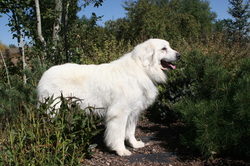Source Unknown

The Great Pyrenees or Pyrenean Mountain Dog is a Mastiff breed that existed in Asia Minor as early as 1800 B.C., based on fossilized remains and depictions in Babylonian paintings. The breed came to Spain with Phoenician traders and eventually became established in the PyreneesMountains between France and Spain. During the Middle Ages, they were guard dogs for sheep flocks and castles of the mobility. In 1675, the future Louis XIV proclaimed them to be the Royal Dog of France. They are ancestors of the Newfoundland and Saint Bernard. The breed was introduced to America in 1824, possibly by General Lafayette. The breed was recognized by the American Kennel Club in 1933. Although primarily a house pet today, many are still used to guard flocks both in their native lands and in the United States.
The Great Pyrenees is an excellent family dog. He is not a heavy eater for his size but does require exercise. Too large to be an apartment dweller, a good-sized yard with plenty of walks is sufficient to keep him trim. He is intelligent and learns quickly but bores easily with repetitive training. He loves children and is an excellent guard dog for both the home and the flock.
The Great Pyrenees' skull is large and wedge shaped with a rounded crown. The ears are set at eye level, triangular in shape with rounded tips and folded down the side of the face. The muzzle is broad with a scissors bite. The eyes are almond shaped, set slightly oblique and dark brown in color. There is a slight excess of skin called the dewlap on the throat. The neck is short and muscular. The chest is deep. The back is straight and broad. It slopes slightly at the rump. The tail hangs to below the hocks and is well plumed. It is carried low unless the dog is alert which causes it to curl up over the back. The gait is a rolling, ambling gait. The coat is double with a heavy, fine white undercoat and a long, thick outer-coat of straighter coarse hair. Coat color is either all white or white with markings of badger, wolf-gray or varying shades of tan. Average height is between 25 and 32 inches. Average weight is between 90 and 130 pounds.
The Great Pyrenees is an excellent family dog. He is not a heavy eater for his size but does require exercise. Too large to be an apartment dweller, a good-sized yard with plenty of walks is sufficient to keep him trim. He is intelligent and learns quickly but bores easily with repetitive training. He loves children and is an excellent guard dog for both the home and the flock.
The Great Pyrenees' skull is large and wedge shaped with a rounded crown. The ears are set at eye level, triangular in shape with rounded tips and folded down the side of the face. The muzzle is broad with a scissors bite. The eyes are almond shaped, set slightly oblique and dark brown in color. There is a slight excess of skin called the dewlap on the throat. The neck is short and muscular. The chest is deep. The back is straight and broad. It slopes slightly at the rump. The tail hangs to below the hocks and is well plumed. It is carried low unless the dog is alert which causes it to curl up over the back. The gait is a rolling, ambling gait. The coat is double with a heavy, fine white undercoat and a long, thick outer-coat of straighter coarse hair. Coat color is either all white or white with markings of badger, wolf-gray or varying shades of tan. Average height is between 25 and 32 inches. Average weight is between 90 and 130 pounds.